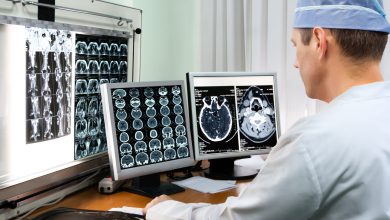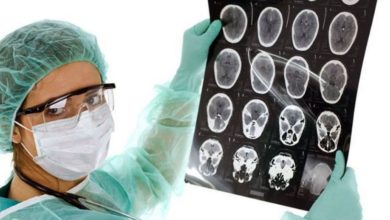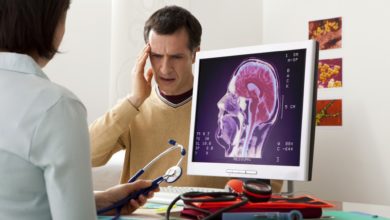Is there a cure for a brain tumor?
The content of the article
The question of whether a brain tumor can be treated is acute for those who have been diagnosed with it. Brain cancer is a serious disease, the causes of which are still not fully understood. It is most common in women and appears in adulthood. The main physiological symptoms are associated with increased intracranial pressure and the impact of the cancer on other organs. The patient often feels dizzy, loses orientation and balance. Severe headaches appear in the first half of the day and towards night. Painful sensations are accompanied by vomiting, most often before the first meal, as well as spontaneous urges throughout the day.
Diagnosis before treatment for brain cancer
Diagnostic methods for detecting brain cancer include:
- An examination by a doctor, during which the patient performs a series of tasks. The health worker will be able to determine from them violations in the coordination and motor skills of the applicant. A neurologist must check the tendon reflex. In addition, a complete medical history is collected.
- MRI with contrast helps to detect the presence of a tumor at an early stage , view the location and prescribe timely treatment.
- A biopsy of brain tissue can reveal not only the presence of a tumor, but also the stage of the cancer. But a biopsy is not always possible due to the difficult-to-reach location of the tumor.
- X-rays also rely on the injection of a contrast agent into the brain. The images can reveal the appearance of a tumor by the displayed vessels.
Average lifespan of patients with brain cancer
To assess the patient’s physical condition and the development of oncology, doctors use the concept of “five-year survival rate.” In this case, all patients with this diagnosis are assessed, regardless of the course of treatment and therapy. With successful therapy, patients will live much more than five years, but most of them will have to undergo ongoing medical examinations and procedures.
Brain cancer treatment
Effective treatment of brain cancer requires the participation of doctors of various specializations. The therapist, oncologist, radiologist, neurologist interact, and the participation of a neurosurgeon and rehabilitation specialist is also necessary. The whole process begins with a diagnosis in the therapist’s office, and after the appointment, an examination by other specialists and examinations are already scheduled.
The plan of treatment procedures directly depends on the patient’s age group. There are three of them:
- junior (up to 19 years old);
- average (yes 55 years);
- older.
Treatments for brain tumors include radiation therapy , surgery, and radiotherapy. Removing a cancerous tumor through surgery is the most reliable method of treatment. But the difficult-to-reach location of the tumor sometimes makes it impossible to perform surgery. Also, surgical intervention is not used at the third and fourth stages of the disease. Firstly, this carries great risks for the patient’s health, and secondly, it is ineffective, since by this period the cancer cells have already affected vital organs and sections of the brain, and it is impossible to completely remove the tumor.
Treatment with surgery
Surgical removal of a brain tumor is a reliable and effective method of treating cancer in the early stages. It is most effective for benign tumors. But there is great danger in brain surgery, and the surgeon cannot remove part of the tissue closest to the tumor in order to prevent relapse and spread of cancer cells.
Surgical interventions for brain diseases must be carried out with maximum precision. The slightest mistake and a millimeter of damaged tissue can cost the patient his life. In severe, late stages of the disease, surgery is ineffective. Pathological processes are already spreading, and it is simply impossible to remove parts of the infected cells. Palliative therapy helps reduce the pressure that a cancerous tumor puts on nearby organs and tissues. After the operation, the patient undergoes a course of drug treatment and chemotherapy, which stops the brain tumor; whether he is treated or not cannot be answered unequivocally.
In the first and second stages of a benign tumor, the symptoms of brain cancer are completely eliminated. This suggests that if detected early, the prognosis for the patient will be more than favorable. If the operation is complicated by the difficult-to-reach location of the tumor, then a more accurate study will be required that will determine the location of the tumor. To classify the stage of cancer, your doctor will take a biopsy of your brain tissue.
Tissue damage during surgery can cause irreversible consequences in the body. To prevent negative manifestations, the method of meteoric radiosurgery is used. This is a high-precision surgical intervention based on the radiation of gamma rays or X-ray irradiation in high doses. Is it possible to cure a brain tumor without consequences? This effect allows you to destroy cancer. Healthy brain tissue is hardly affected or is damaged with minimal, insignificant effect. This technique can also be applied depending on the location of the tumor and the stage of its development. Such treatment minimizes the risk of injury from surgery and complications, and also reduces rehabilitation after the intervention.
Before the operation, doctors carry out drug therapy, which consists of:
- Anticonvulsants. They are used in the second and subsequent stages of cancer, and save from epileptic seizures.
- Steroid anti-inflammatory drugs. Reduce the pressure of the neoplasm on neighboring tissues. The most commonly used drug is descamethasone, a proven and reliable remedy.
To reduce increased intracranial pressure, shunting can be used, during which excess cerebrospinal fluid is removed through a catheter.
Radiation therapy
Radiation therapy in the treatment of brain tumors is necessary in the following cases: the patient cannot undergo surgery for health reasons or to prevent relapse after surgery. Chronic diseases of the cardiovascular system, pathologies in combination with surgery can cause irreparable harm to health. Surgery will not produce results in the later stages of the disease, and it can also be dangerous. The only effective method remains radiation therapy. This technique helps prevent the oncological process after removal of a cancerous tumor.
For each patient, the radiation dose is prescribed by the doctor individually. The impact on the tumor is carried out locally so that as little as possible of the radiation affects the tissues adjacent to the tumor. When prescribing radiation therapy, the specialist takes into account the size of the tumor, stage and location.
There are two types of such treatment:
- Brachytherapy. The technique is intended for patients undergoing inpatient treatment. Special substances are injected into the tumor to act on it from the inside. The dose of the radioactive isotope is precisely calculated to affect only the neoplasm and leave healthy cells unharmed.
- External radiation therapy. The course lasts several weeks with a break of 2 days. During treatment, the patient receives a large dose of radiation, which gradually kills the tumor.
Chemotherapy cannot be considered a panacea for cancer. Therefore, the question: whether brain cancer can be cured remains open. Despite its effectiveness, such an effect almost never excludes a negative impact on other human organs. When drawing up an individual course of treatment, the doctor also prescribes medications. These can be antibiotics, antimetabolites, drugs of the alkylating group. Irradiation is carried out intermittently, during which a specialist can examine the progress of treatment. The main danger of chemotherapy is the effect on the circulatory system and digestive tract.
Endoscopic treatment
Endoscopy is less dangerous than other neurosurgical interventions in the brain, although it is also an operation. This is due to the use of modern medical equipment, which allows for minimal incisions. In a routine operation, doctors perform a brain trepanation, opening the skull. This is not only dangerous to human life, but also prolongs the patient’s rehabilitation period. So can brain cancer be cured safely? Endoscopic treatment is carried out without serious consequences for the brain, minimizing possible damage to blood vessels, cells, and tissues - this is a fundamental part of a safe operation.
How to treat brain cancer?
One of the most dangerous diseases is brain cancer. The possibility of normal processing of incoming and outgoing information depends on the nerve endings between the hemispheres. Thus, during treatment there is always a risk of negative effects on healthy organs. The slightest mistake or deviation can cause amnesia, decreased or loss of intelligence, paralysis and other disorders.
The high risk forces neurosurgeons and other specialists to look for ways to cure the disease and develop new treatment methods that are safer for the patient. Japanese scientists have made great progress in this research. Their innovative technique is based on the use of atomic hydrogen. Medical care in Japan and the development of modern technologies are at a high level, each remedy or method of treatment undergoes the strictest control.
Research into the effects of atomic hydrogen on human cells and organs for the treatment of various diseases began 10 years ago. At this time, a positive trend is also observed when affecting cancer tumors. It is worth noting that the speed of such treatment is much lower than with traditional surgery, but much safer. Researchers were able to establish that after a 5-month course of regular procedures, the tumor significantly decreases in size and subsequently completely disappears. This is clearly demonstrated in X-ray images of cancer patients.
Interestingly, the innovative technology is based on Soviet research, in which they tried to cure viral or bacterial diseases by heating the body to 42 degrees.
In this state, the so-called heat shock protein is released, which can help identify the tumor. Then the study was closed due to the high risk of protein damage in the body. The Japanese, in this technique, decided to use not only heated water, but atomic hydrogen. With the help of the interaction of active hydrogen particles, artificially created hyperthermia occurs without consequences for the human body. An undoubted advantage is the possibility of performing the procedure for older people, because most of the patients are of retirement age.
Modern medicine has advanced in the treatment of cancer, but the effectiveness of any technique depends on the timely detection of the disease. But a complete recovery and the answer to the question: can brain cancer be cured cannot be given by any specialist.
Please rate the article:





